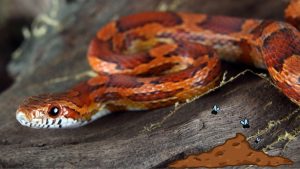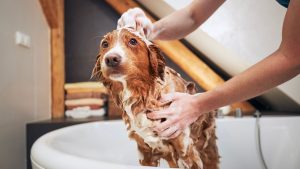Corn snakes are a popular choice for reptile enthusiasts due to their docile nature and low-maintenance requirements. As with any pet, understanding their digestive system and bowel movements is crucial to ensuring their health and well-being. So, how often do corn snakes poop?
Corn snakes typically poop 3-5 days after eating a meal, with baby corn snakes pooping more frequently than adults. The frequency of their bowel movements is directly related to their feeding schedule, so if you’re feeding your corn snake once a week, you should expect them to poop once a week. However, it’s important to note that corn snakes have an efficient digestive system, which means they produce very little waste.
As a corn snake owner, it’s essential to monitor their bowel movements and make sure they’re hydrated. Signs of constipation or impaction should be addressed promptly to prevent further health complications. Additionally, providing the right enclosure conditions and consulting with a veterinarian when necessary are crucial responsibilities of a snake owner.
Understanding Corn Snake’s Digestive System
As a carnivorous species, corn snakes have a digestive system that is specifically designed to process prey items. Understanding how their digestive system works is important for ensuring the health and well-being of your pet snake.
When a corn snake consumes a meal, the food travels down their esophagus and into their stomach. Unlike humans, snakes do not have a separate stomach and small intestine. Instead, their stomach is elongated and has a series of folds that help break down the food.
Once the food is broken down, it moves into the small intestine where nutrients are absorbed into the bloodstream. The remaining waste products then move into the large intestine where water is reabsorbed and the waste is formed into feces.
It is important to note that corn snakes can take anywhere from 3-5 days to fully digest a meal. During this time, it is normal for them to not eat or defecate. However, once they have fully digested their meal, they will typically defecate within a few days.
When feeding your corn snake, it is important to provide appropriate prey items that are the right size for their age and size. Overfeeding can lead to health problems, while underfeeding can result in malnutrition.
In addition, it is recommended to wait at least 48 hours after feeding before handling your snake to allow them time to fully digest their meal. Handling too soon after feeding can cause regurgitation and other digestive issues.
Overall, understanding your corn snake’s digestive system and providing appropriate feeding and care is essential for their health and well-being.
Frequency of Corn Snake’s Poop
As a corn snake owner, it’s important to understand how often your pet should be pooping to ensure their health and wellbeing. The frequency of corn snake poop can vary depending on several factors, including age, size, and diet.
Adult corn snakes typically poop once a week, while juvenile and baby corn snakes may poop slightly more often due to their more frequent feeding schedule. However, it’s important to note that the frequency of poop can vary from snake to snake, so it’s important to pay attention to your individual pet’s habits.
If your corn snake isn’t pooping as often as usual, it could be a sign of constipation or other health issues. On the other hand, if your snake is pooping more frequently than usual, it could be a sign of overfeeding or an improper diet.
To ensure that your corn snake is pooping regularly and staying healthy, make sure to provide them with a balanced diet and proper care. This includes feeding them the appropriate amount of food based on their age and size, providing them with a clean and comfortable living environment, and monitoring their poop habits for any changes or irregularities.
Overall, understanding the frequency of corn snake poop is an important aspect of owning and caring for these fascinating reptiles. By staying informed and attentive to your pet’s needs, you can help ensure that they live a happy and healthy life.
Diet’s Impact on Poop Frequency and Health
The diet of a corn snake has a significant impact on its poop frequency and health. As a carnivorous species, corn snakes require a diet that consists of prey items such as mice, rats, and other small rodents. The size of the prey item should be appropriate for the size of the snake. Feeding your snake too large of a meal can lead to digestive issues and constipation, while feeding it too small of a meal can result in malnutrition.
A healthy diet will ensure that your corn snake has regular bowel movements. Healthy adult corn snakes typically poop about 3 to 5 days after eating a meal, or around once a week. However, this varies slightly depending on your snake’s age, level of hydration, and overall digestive health. Snakes that are not fed a balanced diet may experience irregular bowel movements, constipation, or diarrhea.
It is essential to provide your corn snake with a varied diet that includes different types of prey items. This will ensure that your snake receives all the necessary nutrients and minerals that it needs to maintain good health. Additionally, a varied diet can help prevent your snake from becoming bored with its food, which can lead to a loss of appetite.
In summary, the diet of a corn snake plays a crucial role in its poop frequency and overall health. It is important to feed your snake a balanced diet that consists of appropriate-sized prey items and a variety of different prey items. By doing so, you can ensure that your corn snake has regular bowel movements and maintains good health.
Importance of Hydration
As a corn snake owner, it’s important to understand the role of hydration in your pet’s health. Corn snakes require water to stay hydrated and maintain their bodily functions. Without proper hydration, your snake could experience digestive problems, dehydration, and other health issues.
To ensure your corn snake stays hydrated, provide a clean water dish at all times. The dish should be large enough for your snake to soak in if they choose to do so. Change the water daily to prevent the buildup of bacteria and other harmful substances.
It’s also important to monitor your snake’s hydration level. Signs of dehydration include sunken eyes, dry skin, and lethargy. If you notice any of these symptoms, it’s important to provide your snake with drinking water immediately.
In addition to providing a water dish, you can also mist your snake’s enclosure to increase humidity levels and promote hydration. Just be sure to avoid getting water on your snake’s head or in their eyes, as this can cause stress and discomfort.
Overall, maintaining proper hydration is essential for your corn snake’s health and well-being. By providing clean water, monitoring hydration levels, and promoting humidity, you can help ensure your snake stays healthy and happy.
Signs of Constipation and Impaction
If your corn snake is not pooping regularly, it may be constipated or impacted. Constipation occurs when the snake is unable to pass waste from its vent, while impaction occurs when the snake ingests something that its body cannot digest. Here are some signs to look out for:
- Lethargy and loss of appetite
- Straining to poop without success
- Swollen belly
- Lack of fecal matter in the enclosure
- Discomfort when touched around the belly area
If you suspect that your corn snake is constipated or impacted, you can try giving it a belly massage. This can help stimulate the digestive tract and encourage the snake to pass waste. To do this, gently massage the snake’s belly in a circular motion for a few minutes each day.
However, if the constipation or impaction persists, it is important to seek veterinary treatment. A vet can provide additional treatments such as administering mineral oil or performing a procedure to remove the impacted material.
To prevent constipation and impaction, make sure to provide your corn snake with a balanced diet and proper enclosure conditions. Ensure that the enclosure temperature and humidity are appropriate, and avoid feeding your snake prey that is too large for it to digest properly.
Overall, it is important to monitor your corn snake’s bowel movements and seek veterinary attention if you notice any signs of constipation or impaction.
Role of Enclosure Conditions
The enclosure conditions play a crucial role in the digestive health of your corn snake. As a responsible owner, it is important to maintain the right temperature and humidity levels in the enclosure to ensure your snake’s comfort and well-being.
Corn snakes require a temperature range of 75-85°F (24-29°C) during the day and a drop of 5-10°F (2-5°C) at night. Ensure that you have a reliable thermometer to monitor the temperature in the enclosure. A temperature that is too low can lead to digestive problems and constipation, while a temperature that is too high can cause dehydration and other health issues.
Humidity is also an important factor to consider. Corn snakes require a humidity level of 40-60%. You can use a hygrometer to monitor the humidity level in the enclosure. Low humidity levels can cause dehydration and difficulty in passing stools, while high humidity levels can lead to respiratory problems.
To maintain the right humidity level, you can provide a water dish in the enclosure and mist the enclosure regularly. Ensure that the substrate in the enclosure is not too damp or too dry.
Climbing branches are also important for your corn snake’s well-being. They provide exercise and enrichment for your snake, and can also help with digestion. Corn snakes are known to climb trees in their natural habitat, so providing climbing branches in the enclosure can mimic their natural behavior.
In summary, maintaining the right temperature, humidity, and providing climbing branches in the enclosure can help promote healthy digestion and overall well-being for your corn snake.
Impact of Brumation on Bowel Movements
During the winter months, corn snakes may enter a state of brumation, which is similar to hibernation in mammals. This period of inactivity can last anywhere from a few weeks to several months, and during this time, the snake’s metabolism slows down significantly. As a result, their bowel movements may become infrequent or even stop altogether.
If your corn snake is in brumation, you may notice a decrease in their appetite, activity level, and bowel movements. This is a normal part of their natural cycle, and you should not be alarmed unless you notice any other signs of illness or distress.
It’s important to note that heat plays a significant role in a snake’s digestive system. During brumation, the snake’s body temperature drops, and this can slow down their digestion and bowel movements. Therefore, it’s crucial to provide a proper heat source for your snake during this time to ensure their digestive system stays healthy.
Location can also impact a snake’s bowel movements. If your snake is in a stressful or unfamiliar environment, they may hold in their bowel movements until they feel more comfortable. Ensure that your snake has a suitable and comfortable enclosure to prevent any stress-related issues.
In summary, brumation can have a significant impact on a corn snake’s bowel movements. It’s essential to provide a proper heat source and a comfortable environment to ensure their digestive system stays healthy during this time. If you notice any signs of illness or distress, consult with a veterinarian who specializes in reptiles.
The Role of Veterinarian
As a corn snake owner, it’s important to have a veterinarian who specializes in reptiles. A reptile veterinarian can provide you with valuable information about your corn snake’s health, including its digestive system and bathroom habits.
If you notice that your corn snake is not pooping regularly or is experiencing any other digestive issues, it’s important to seek veterinary care immediately. Your veterinarian can perform a physical exam and run diagnostic tests to determine if there is an underlying illness or infection causing the problem.
Some common causes of digestive issues in corn snakes include parasites, stress, and improper diet. Your veterinarian can help you identify the cause of the problem and provide appropriate treatment.
In addition to treating illnesses and infections, your veterinarian can also provide preventative care for your corn snake. Regular check-ups and fecal exams can help detect potential health issues before they become serious.
Overall, having a reptile veterinarian on hand is essential for maintaining your corn snake’s health and well-being. By working with a knowledgeable and experienced veterinarian, you can ensure that your corn snake stays healthy and happy for years to come.
Responsibilities of a Snake Owner
As a snake owner, it is your responsibility to ensure that your pet snake is healthy and happy. Being a responsible snake owner means that you have the knowledge and resources to provide your pet with everything it needs to live a healthy life.
One of the most important aspects of being a responsible snake owner is providing your pet snake with the appropriate amount of activity. While snakes are generally low-maintenance pets, they still require regular handling and exercise to stay healthy. This means that you should take your snake out of its enclosure for at least 15-20 minutes a day to allow it to stretch and move around.
In addition to providing your pet snake with regular activity, you should also ensure that its enclosure is clean and well-maintained. This includes regularly cleaning the enclosure, providing fresh water and appropriate food, and monitoring your snake’s health for any signs of illness or injury.
Handling your pet snake is also an important responsibility of a snake owner. While handling your snake can be a fun and rewarding experience, it is important to remember that snakes can be unpredictable and potentially dangerous. As such, it is important to always handle your snake with care and respect to avoid any accidents or injuries.
Overall, being a responsible snake owner requires a commitment to providing your pet snake with everything it needs to live a happy and healthy life. By staying knowledgeable about your pet’s needs and providing it with appropriate care and attention, you can enjoy a rewarding and fulfilling relationship with your pet snake.
Frequently Asked Questions
How often should I expect my corn snake to defecate?
On average, corn snakes defecate every 3-5 days after eating. Adults typically defecate once per week, while juveniles may defecate slightly more often.
What does normal corn snake feces look like?
Normal corn snake feces should be brown and solid, with a texture similar to that of a sausage. If the feces are runny or have an unusual color or odor, it may indicate a health issue.
Can corn snakes hold their poop for an extended period of time?
Yes, corn snakes can hold their poop for an extended period of time, but it is not recommended. Holding in feces can lead to constipation and other health issues.
Do corn snakes need to pee in addition to pooping?
No, corn snakes do not urinate like mammals do. Instead, they excrete uric acid, which is combined with their feces and expelled together.
How long can a corn snake go without defecating?
While it is normal for corn snakes to go a few days without defecating, it is not healthy for them to go longer than a week without doing so. If your corn snake has not defecated in over a week, it may be a sign of constipation or other health issues.
Is it normal for a corn snake to not poop for a few weeks?
No, it is not normal for a corn snake to go more than a week without defecating. If your corn snake has not defecated in a few weeks, it may be a sign of a health issue that requires veterinary attention.
Author
-

Jess is a lifelong pet lover, known for her profound passion for animals. With a wide range of pets, from cats and dogs to fish and hamsters, she has experienced the joys and challenges of pet ownership firsthand. Her writing captures the unique bond between humans and pets, sharing heartwarming anecdotes and practical advice. Jess’s deep understanding of animal behavior and commitment to responsible pet care make her a valuable resource for fellow pet enthusiasts. Through her words, she continues to inspire and educate, fostering meaningful connections between humans and their beloved furry companions.








